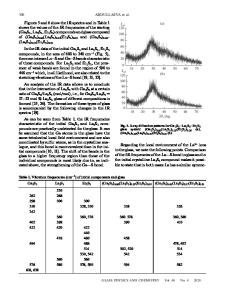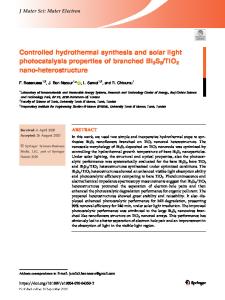Synthesis and Aggregation of BiBi 2 S 3 Nanocapsules
- PDF / 810,818 Bytes
- 6 Pages / 612 x 792 pts (letter) Page_size
- 54 Downloads / 496 Views
Z3.36.1
Synthesis and Aggregation of Bi2S3 Nanocapsules Marina Vega-González, Xim Bokhimi, Manuel Aguilar-Franco, Antonio Morales and Amado F. García-Ruiz1. Institute of Physics, The National University of Mexico (UNAM), A.P. 20-364, 01000 México D. F. Mexico. 1 UPIICSA-COFAA, The National Polytechnic Institute (IPN), Té 950 Esq. Resina, 08400, México, D. F. Mexico. ABSTRACT Nanocapsules of Bi2S3 with diameters between 5 and 10 nm and shells with an amorphous atomic distribution were synthesized at room temperature, with bismuth nitrate and thiourea as precursors. Aging the solution for several days a black powder precipitated made of a mixture of one amorphous phase and crystalline Bi2S3. When two capsules interacted between each other, the capsule regions in contact crystallized into bismuth sulfide, which explains the origin of the crystalline phase observed in the X-ray diffraction pattern. At this temperature, aggregation of the small nanocapsules also gave rise to necklaces of capsules, which eventually gave rise to nanotubes; these necklaces ordered forming bundles parallel to their largest dimension. When the solution was annealed at temperatures lower than 100 ºC, aggregation gave rise to capsules as large as 1 µm in diameter, and tubes with similar diameters; in this case aggregation occurred between small and large nanocapsules. Because of the monomers aggregating had an external spherical symmetry and the low annealing temperatures, which were not high enough to produce sintering, all capsules and tubes formed during aggregation had porous walls, making these materials interesting for many applications. INTRODUCTION Bismuth tri-sulfide, Bi2S3, has a direct bandgap of 1.3 eV and absorbs across the visible spectrum [1,2], which makes it an interesting non-toxic material that can be applied as a main component in solar energy conversion devices [3]. For example, it has been used in the construction of photodiode arrays and photovoltaics [4,5]. The presence of this compound as nanoparticles in polymers photovoltaics improves not only light collection efficiency, but also the coating efficiency against photocorrosion [6]. Bi2S3 also belongs to the family of materials with applications in thermoelectric cooling technologies based on Peltier’s effect [7]. Since it absorbs visible light [8-10] independently of the particle size [11] and is an inorganic material that can work at high temperatures and is stable by the interaction with photons, it can substitute for the organic dyes than are combined with nanocrystalline titanium oxide solar cells [12] for working in the visible region. Of course, this combination would also be very useful in photocatalysis in the region of the visible light. The crystalline structure of Bi2S3 has an inherent chain type structure [13] that favors crystallite growing forming preferentially rods [14], which can be made even at room temperature by changing the acidity of the solution [15]. Most of the reports on Bi2S3 are related to their synthesis as crystalline nanorods using chemi
Data Loading...











